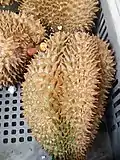Among the thirty known species of Durio, so far eleven species have been identified to produce edible fruits. However, there are many species for which the fruit has never been collected or properly described and it is likely that other species with edible fruit exist.[1] The currently known nine species of edible durians are:
| Image | Name | Common name | Distribution | Description |
|---|---|---|---|---|
 | Durio dulcis Becc. | durian marangang (or merangang), red durian, tutong, or lahong | Sabah and West Kalimantan, Borneo | |
| Durio grandiflorus Kosterm. & Soegeng' | ghost durian, durian munjit, durian hantu hutan, Sukang | Borneo | ||
 | Durio graveolens Becc. | Trako, tabelak, durian burung, durian kuning, durian merah, durian otak udang galah, red-fleshed durian | Southern Thailand, Peninsular Malaysia, Sumatra, Borneo, Palawan (Philippines) | It is a large tree up to 50 m (160 ft) tall. The husk of its fruit is orange-yellow, covered with pyramidal 1 cm (0.4 in) long spines. The fruit has sweet crimson-coloured flesh and a fragrance of roasted almonds. D. graveolens resembles D. dulcis but its fruit opens while it is still on the tree and has dark red flesh, whereas the fruit of D. dulcis drops unopened and has dark yellow flesh. Durian suluk, also known as durian siunggong, is a natural hybrid between D. zibethinus and D. graveolens, and retains the flavour and texture of D. zibethinus with subtle burnt caramel overtones of D. graveolens. Durian simpor is a mild-flavoured, yellow-fleshed variant of D. graveolens. |
| Durio kinabaluensis Kosterm. & Soegeng | Mountain Durian | Crocker Range and Mount Kinabalu, Sabah | ||
 | Durio kutejensis (Hassk.) Becc. | durian pulu, durian merah, nyekak, Pakan, Kuluk, or lai | Borneo | |
| Durio lowianus Scort. ex King | durian duan, durian sepeh, durian au, Thurian-don | Peninsular Malaysia, Southern Thailand, and Sumatra | It is a large tree up to 50 metre tall, has red flowers and elongated. Its oval-shaped fruit contains yellow flesh. | |
| Durio macrantha Kosterm. | Mt. Leuser National Park, North Sumatra | |||
| Durio mansoni (Gamble) Bakh. | Tan duyin, Turimi | Thailand and Myanmar | ||
 | Durio oxleyanus Griff. | durian sukang, durian beludu, isu or kerontangan | Peninsular Malaysia, Sumatra, and Borneo | It is a fairly large tree up to 40 m (130 ft) tall. It produces small, round, greyish-green fruits with large, stiff, broadly pyramidal, slightly curved spines. The flesh is yellow, smooth-textured and sweet. |
| Durio testudinarius Becc. | tortoise or kura-kura durian | Borneo | It is a medium-sized tree up to 25 m (82 ft) tall. Being a self-pollinated species, it is less variable, and has an extended flowering season. The flesh of its fruit is pale yellow and has a stronger aroma than other species of Durio. | |
| Durio wyatt-smithii Kosterm. | Peninsular Malaysia (Trengganu) | |||
 | Durio zibethinus L. | Borneo and Sumatra | ||
The other species, which haven't been identified to produce edible fruits are:
| Image | Name | Common name | Distribution | Description |
|---|---|---|---|---|
| Durio acutifolius (Mast.) Kosterm. | Tupaloh, durian burung, Durian anggang, Tuwola pupulu, durian lojang, Lai Kuju | Kalimantan and Sabah | ||
| Durio affinis Becc. | duan tajam | West Kalimantan and Sabah. | ||
| Durio beccarianus Kosterm. & Soegeng | Indonesian West Borneo, Upper Kapuas River | |||
| Durio bukitrayaensis Kosterm. | Borneo | |||
| Durio burmanicus Soegeng | Myanmar | |||
| Durio carinatus Mast. | Sumatra, Pahang, Johor, Sabah, Sarawak and Brunei | |||
| Durio ceylanicus Gardner | Ceylon durian | Sri Lanka | ||
| Durio crassipes Kosterm. & Soegeng | Tenom and Sipitang areas of Sabah. | |||
| Durio excelsus (Korth.) Bakh. | Apun; Durian daun; Begurah | Kalimantan | ||
| Durio gerikensis M.N.Faizal, Edward, Latiff & Hadrul | Peninsular Malaysia. | |||
| Durio griffithii (Mast.) Bakh. | Simartarutung | Peninsular Malaysia, Sumatra, Borneo. | ||
| Durio lanceolatus (Mast.) | Bian, Dian perai, Durian, Durian anggang, Durian bengan, Durian burong, | Borneo | ||
| Durio lissocarpus Mast.: | Durian burung | Borneo | ||
| Durio macrolepis Kosterm. | Peninsular Malaysia. | |||
| Durio macrophyllus (King) Ridl. | tong, daun, batan, daun besar, pumkubm (Batak) | Peninsular Malaysia | ||
| Durio malaccensis Planch. ex Mast. | batang, tong Durian batang, durian bangko, durian bankolo | Peninsular Malaysia, Sumatra. | It is normally white-flowered, but some D. malaccensis with reddish flowers have been discovered in Johor State, perhaps from cross-pollination by the pink or red-flowered D. lowianus and D. pinangianus.[2] | |
| Durio oblongus Mast. | Sarawak. | |||
| Durio pinangianus (Becc.) Ridl. | daun tajam, burung | Peninsular Malaysia (Perak, Penang). | ||
| Durio purpureus Kosterm. & Soegeng | West Kalimantan | |||
| Durio singaporensis Ridl. | durian daun, bujur | Peninsular Malaysia. | ||
See also
References
- ↑ Brown, Michael J. (1997). Durio — A Bibliographic Review. International Plant Genetic Resources Institute. ISBN 978-92-9043-318-7.
- ↑ Morton, J. F. (1987). Fruits of Warm Climates. Florida Flair Books. ISBN 978-0-9610184-1-2.
Wikimedia Commons has media related to Durio.
This article is issued from Wikipedia. The text is licensed under Creative Commons - Attribution - Sharealike. Additional terms may apply for the media files.
